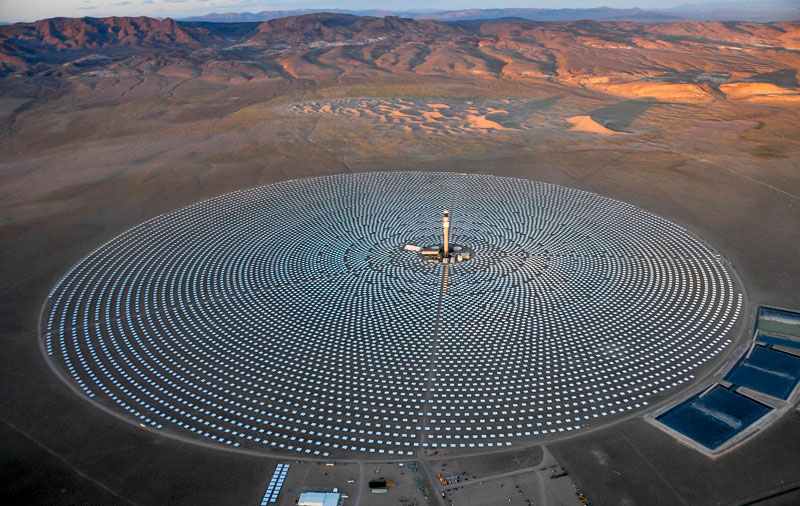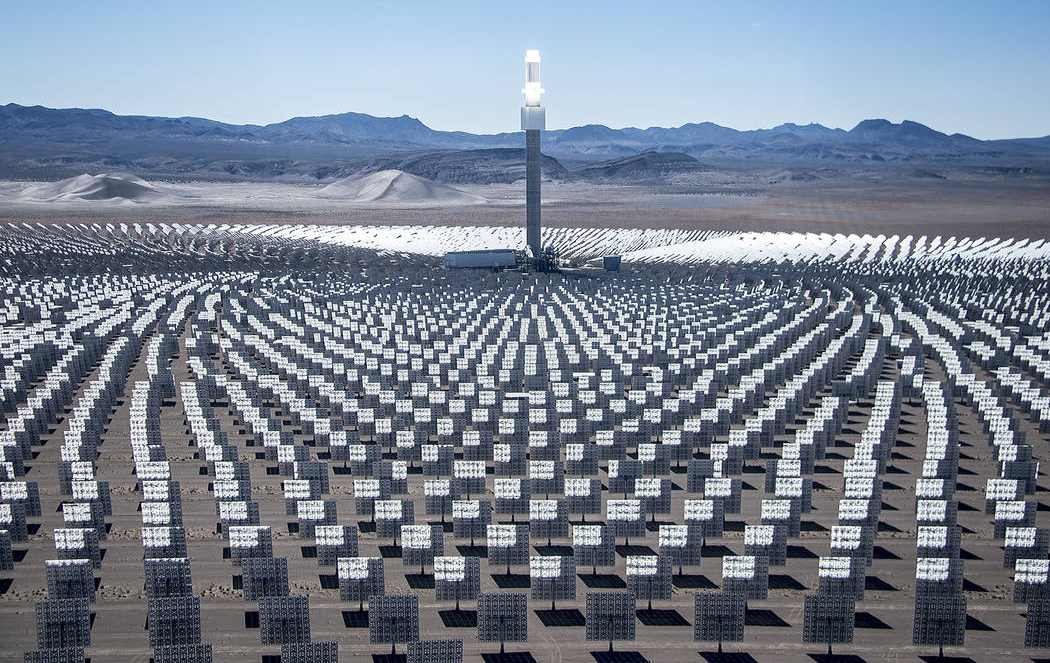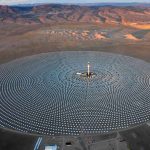The $1 billion boondoggle solar plant project failure that was obsolete before it ever went online: Is Biden’s $2.25 trillion infrastructure, clean energy plan another boondoggle project?

Last month, we wrote a piece about why renewables can’t save the planet and how renewables destroy the environment to save the climate. The article was based on an honest assessment of renewable energy like solar and wind by lifelong environmentalist Michael Shellenberger.
As a life-long environmental activist and Time Magazine “Hero of the Environment” and a celebrated author, Shellenberger has worked with investors, labor unions, and the Obama administration to invest $150 billion into renewables. Michael Shellenberger is also the President of Environmental Progress, a research and policy organization.
After seeing the devastating effects of renewables like solar and winds, he later became a pro-nuclear environmentalist. Shellenberger changed his mind about nuclear energy and has helped save enough nuclear reactors to prevent an increase in carbon emissions equivalent to adding more than 10 million cars to the road. You can read more about the story here.
But why is Shellenberger’s story so important? Last month, the Biden administration announced several measures to curb climate change. According to the White House, many of these clean-energy measures, such as funding for electric vehicles, the building solar projects, wind energy, 500,000 electric vehicle (EV) charging stations, and retrofitting buildings and residences, would help the president achieve a goal of net-zero emissions by 2050. If signed into law, the $2 trillion initiative would rank as one of the largest federal efforts ever to stop greenhouse gas emissions in the United States.
However, there is only one problem with some of Biden’s climate plan measures. As Shellenberger pointed out, renewables like solar and wind have devastating effects on the environment. Besides, if history is any guide, the U.S. government has lost billions of dollars on several government-backed solar projects. For example, The Nevada solar-energy plant Crescent Dunes is considered the world’s biggest solar energy project failure. Backed by a $737 million federal loan guarantee during the Obama Administration, the project was anticipated to cost less than $1 billion but the solar plant project became obsolete before it ever went online.
Crescent Dunes is not the only failed solar project. Remember Solyndra? More than half a billion dollars taxpayers money with to the bankrupt energy company. On March 20, 2009, then-Secretary of Energy Steven Chu announced Solyndra as the recipient of a $535 million loan from his department under the Obama administration’s revamped loan guarantee program.

How it all started
Like Solyndra, Crescent Dunes is another Obama Administration failure in solar energy development. Despite the red flags that Crescent Dunes’ power was priced over 4 times as high as the nearest photovoltaic plant in Nevada, the Obama Administration still went ahead and invest in the failed project with taxpayers’ money to further its development of renewable technology.
As we all know, the sun has an infinite amount of energy to generate electricity apparently without toxic pollutants or effects on global warming. It is also true that the current solar energy systems (photovoltaics, solar thermal, solar power) offer significant benefits when compared to conventional energy sources. However, the dark secret of solar energy is rarely talked about. It might surprise you to learn that solar energy has a larger and more destructive environmental footprint than you think.
According to the American National Renewable Energy Laboratory (NREL), the entire lifecycle of renewable energy technologies should be considered before embarking on any solar energy project. In other words, decision-makers need to take into account the overall costs (from economic cost to the long-term cost) and environmental impacts in the construction, installation, and decommissioning phases. In some cases, some of the solar plants don’t even make it to the operational stage. An example of this is the Crescent Dunes Solar Energy Project, one of the futuristic solar plant failures of the 20th century, according to a 257-page report from NREL, titled “Concentrating Solar Power Best Practices Study.”

Developed by SolarReserve and owned by Tonopah Solar Energy, the Crescent Dunes Project is a 110 megawatt (MW) plant located near Tonopah, about 190 miles (310 km) northwest of Las Vegas. Once constructed, it was supposed to power up to 75,000 homes during peak electricity periods.
The project was anticipated to cost less than $1 billion and was backed by $737 million in U.S. government loan guarantees. Crescent Dunes was the first concentrated solar power (CSP) plant with a central receiver tower and advanced molten salt energy storage technology from SolarReserve. According to Bloomberg, a combination of terrible management and simple technological advancement turned the plant into a dinosaur. So, what really went wrong?
It all started in 2011 when the $1 billion solar plants were approved to generate approximately 500,000 megawatt-hours annually of clean, renewable electricity, enough to power 75,000 homes during peak electricity periods. The plant later suffered several technical problems and failed to deliver its intended 50% capacity factor, only achieving about a 20% capacity factor in 2018, and eventually closed in 2019.
SolarReserve is a venture-backed renewable energy startup, focuses on advanced solar thermal storage technology. The startup was founded in 2007 by Kevin Smith to solve two of the fundamental barriers of renewable energy: scalability and storage. Unlike hydroelectric, geothermal, biomass, and other renewable energy technologies that use limited renewable fuel sources.
Its power plants draw their heat from the sun – earth’s ultimate source of clean energy. Unlike wind and photovoltaics, SolarReserve’s power plants deliver power whenever it is needed, either 24 hours per day or only during “peak” demand. By overcoming these two key barriers, SolarReserve was able to enable utility-scale, clean, renewable electricity generation.
As of May 2015, the startup has already invested $2.8 billion in developing and securing long-term power contracts for 482 megawatts (MW) of solar projects, with a development pipeline of more than 6.6 gigawatts (GW) globally. In 2011, the startup embarked on another $1 billion Crescent Dunes Solar Energy Project near Tonopah, Nevada. The project was to be the biggest solar plant of its kind. Citigroup Inc. and other financiers invested $140 million with its developer, SolarReserve Inc. Steven Chu, the U.S. Department of Energy secretary at the time, offered the company government loan guarantees, and Harry Reid, then the Senate majority leader and senior senator from Nevada, cleared the way for the company to build on public land, according to a report from Bloomberg.
As Bloomberg describes it, “the Crescent Dunes solar plant looks like something out of a sci-fi movie with ten thousand mirrors form a spiral almost 2 miles wide that winds around a skyscraper rising above the desert between Las Vegas and Reno.” The operation soaks up enough heat from the sun’s rays to spin steam turbines and store energy in the form of molten salt. So, what caused a once high-flying startup to shut down its $5 billion Crescent Dunes solar plant in April 2019?
Obsolete Technology and Mismanagement
SolarReserve’s Crescent Dunes solar plant was primarily based on Concentrated Solar Power (CSP) and Photovoltaic (PV) technologies. With solar energy witnessing new innovations, concentrated solar became unsustainable and too expensive to maintain. The steam generators at its solar plant require custom parts and at least 12 people to conduct regular maintenance and keep the plant running. The problem is further compounded with cheap solar coming from the new Nevada photovoltaic solar farm and China. We will talk about China later in the article.
So, for example, the average production cost of concentrated solar thermal energy is much higher than other renewable resources. SolarReserve’s power cost Nevada about $135 per megawatt-hour, compared with less than $30 per MWh today at a new Nevada photovoltaic solar farm. Though during the past few years, the average cost has dropped to $0.20/kWh. Still, the costs are high as in comparison, the average production cost of solar PV is in the range of $0.05 to $0.10/kWh.
The beginning of the end?
CSP was all the rage a decade ago and everything was going well for SolarReserve. CSP technology uses concentrated sunlight to create steam and drive turbines. However, as any technologist will tell you, today’s emerging technology is tomorrow’s legacy. Ten years later, CSP suffers the same fate as many other emerging technologies before it and fell prey to the falling costs of crystalline silicon solar.
With Solar energy witnessing new innovations, many solar companies are experimenting more efficient and cost-effective ways to produce solar energy by making technological breakthroughs. Especially, Chinese solar companies are dominating the solar market by providing low-cost energy using advanced methods. These new innovations may potentially make concentrated solar technology outdated. In a paper titled “The Dragon Awakens: Will China Save or Conquer Concentrating Solar Power?,” the authors from Renewable Energy Policy Group at the Institute for Environmental Decisions at ETH Zürich, said: “The outlook for CSP was bleak and its very survival as a commercial technology seemed to hang in the balance.”
On January 31, 2019, citing the Nevada Bureau of Land Management, the Las Vegas Review-Journal reported that SolarReserve withdrew its application to build the $5 billion concentrated solar array on federal land. The $5 billion CSP project would have included 100,000 mirrors and 10 towers that would have been able to store the sun’s energy and generate power after dark. The decision came after SolarReserve already built one concentrated solar array tower outside of Tonopah. The $1 billion, 110-megawatt Crescent Dunes Solar Energy Plant began delivering power to NV Energy in 2015.

In 2019, SolarReserve’s Concentrated Solar Power technology struggled to stay online after going commercial almost four years ago. CSP is not the only problem, SolarReserve has other concerns. The company faced problems from conservationists and Native American groups who own the areas where SolarReserve operates its plants. According to Las Vegas Review-Journal, some energy analysts raised concerns about the project and maintenance costs associated with concentrated solar projects. Others worried about the project’s potential impact on wildlife and Nevada’s landscape.
Finally, in October 2019, SolarReserve filed suit against the LLC which owns Crescent Dunes, and the U.S. Department of Energy. The lawsuit claims that DOE, which provided a loan guarantee for Crescent Dunes, is stacking the board and trying to push out its sole director,” according to another report from PV Magazine.
In the end, it all comes down to efficiency, innovation. SolarReserve could no longer live on its past glory in the face of cheap and efficient solar panels. There is still hope for the startup of its willingness to develop and embrace newer and better technologies.
To wrap up, we hope the Biden administration can learn from the failure of his predecessor’s green energy program.

